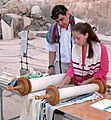Bar and Bat Mitzvah facts for kids
| Part of a series on | |||
|---|---|---|---|
|
|||
| Judaism | |||
| Category | |||
| Jewish religious movements | |||
| Orthodox (Haredi • Hasidic • Modern) | |||
| Conservative • Reform | |||
| Reconstructionist • Renewal • Humanistic | |||
| Jewish philosophy | |||
| Principles of faith • Kabbalah • Messiah • Ethics | |||
| Chosenness • Names of God • Musar | |||
| Religious texts | |||
| Tanakh (Torah • Nevi'im • Ketuvim) | |||
| Ḥumash • Siddur • Piyutim • Zohar | |||
| Rabbinic literature (Talmud • Midrash • Tosefta) | |||
| Religious Law | |||
| Mishneh Torah • Tur | |||
| Shulchan Aruch • Mishnah Berurah | |||
| Kashrut • Tzniut • Tzedakah • Niddah • Noahide laws | |||
| Holy cities | |||
| Jerusalem • Safed • Hebron • Tiberias | |||
| Important figures | |||
| Abraham • Isaac • Jacob | |||
| Moses • Aaron • David • Solomon | |||
| Sarah • Rebecca • Rachel • Leah | |||
| Rabbinic sages | |||
| Jewish life cycle | |||
| Brit • Pidyon haben • Bar/Bat Mitzvah | |||
| Marriage • Bereavement | |||
| Religious roles | |||
| Rabbi • Rebbe • Posek • Hazzan/Cantor | |||
| Dayan • Rosh yeshiva • Mohel • Kohen/Priest | |||
| Religious buildings & institutions | |||
| Synagogue • Beth midrash • Mikveh | |||
| Sukkah • Chevra kadisha | |||
| Holy Temple / Tabernacle | |||
| Jewish education | |||
| Yeshiva • Kollel • Cheder | |||
| Religious articles | |||
| Sefer Torah • Tallit • Tefillin • Tzitzit • Kippah | |||
| Mezuzah • Hanukiah/Menorah • Shofar | |||
| 4 Species • Kittel • Gartel | |||
| Jewish prayers and services | |||
| Shema • Amidah • Aleinu • Kaddish • Minyan | |||
| Birkat Hamazon • Shehecheyanu • Hallel | |||
| Havdalah • Tachanun • Kol Nidre • Selichot | |||
| Judaism & other religions | |||
| Christianity • Islam • Judeo-Christian | |||
| Abrahamic faiths | |||
| Related topics | |||
| Antisemitism • The Holocaust • Israel • Zionism | |||

In Judaism, a Bar Mitzvah is a special event for a Jewish boy. A Bat Mitzvah is the same event for a Jewish girl. This happens when they turn 13 years old. For girls in the Orthodox Jewish tradition, it is at 12 years old. It is a rite of passage that shows the young person is now responsible for themselves.
Before this age, parents are responsible for their child's actions. After a Bar or Bat Mitzvah, the young person takes on their own responsibilities. They can then take part in all areas of Jewish community life. It is a big step that marks their coming of age. The words "Bar Mitzvah" and "Bat Mitzvah" also refer to the celebration itself.
What do the words mean?
The words Bar Mitzvah and Bat Mitzvah come from the Aramaic language.
- Bar Mitzvah means "one (male) to whom the commandments apply". The word Bar means "son" in Aramaic.
- Bat Mitzvah means "one (female) to whom the commandments apply". The word Bat means "daughter" in Aramaic.
Why is it important?
According to Jewish law, Jewish children become adults at this age. This means they become a Bar or Bat Mitzvah. This is also usually when puberty begins.
Before this time, parents are responsible for teaching their children Jewish law and traditions. After this age, young people become responsible for following these laws themselves. They can also take part in all parts of Jewish community life. This includes reading from the Torah during services.
Images for kids
-
An 1839 description of an upcoming Manhattan bar mitzvah reported in the New York Herald.
-
Bar mitzvah at the Western Wall in Jerusalem
-
Bar mitzvah ceremony at a Reform synagogue
-
A Conservative bat mitzvah in Israel
-
Reading from the Torah (Sephardi custom)
See also
 In Spanish: Benei Mitzvá para niños
In Spanish: Benei Mitzvá para niños












